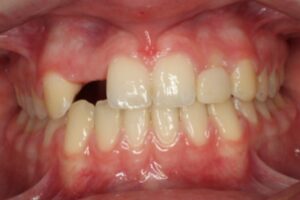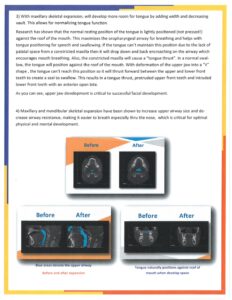Increased Overbite (Class II)
July 7th, 2021
HOW DID WE GET HERE
The most common treatment in Orthodontics is for an increased overbite (Class II). It is also the most unpredictable because of the need for increased patient cooperation, (i.e. wearing rubber bands) the above patient had a unilateral Class II which we used braces and a TAD (Temporary Anchorage Device) to correct. The TAD takes the unpredictability out of the treatment because of the patient cooperation and the direct mechanics
Placing a TAD requires topical anesthetics. We can place one in 3 to 5 minutes. TAD’s are the way to go for predictable Class II treatment.
Also, we did some enamelplasty to smooth the rough edges on the upper front teeth (Centrals) and enamel reduction between these teeth to resolve the “black triangle.
Preteens or Teens With Missing Front Teeth
April 14th, 2021
Preteens Or Teens With Missing Front Teeth
How did we get here?
Do you have a child with a missing upper front tooth? If you do, this blog will provide useful information to help you decide what to do.
There are 3 options.
1) If there is a baby tooth in the position of the missing tooth, keep it . This is not a long term proposition because the baby tooth will be lost (you’ll be lucky if the tooth last 15 years).
2) Open space for the missing tooth– This is usually the best if you are missing one front tooth, as closing the space for one tooth can create an asymmetry. In the photos below the patient is missing one front tooth. With orthodontics, we created space for the tooth then her dentist placed a Maryland Bridge. 

3) Close space for the missing tooth (teeth). This option when possible is the best solution long term as it can alleviate the need for further dental treatment (i.e. the need to replace 2 missing teeth). If handled properly the esthetics of the smile are significantly enhanced. Also you avoid the long term cost for the repeated replacement of the restorations (expect to replace each restoration 4 times over a lifetime). The patient below is a perfect example of this. We closed the space for the two side front teeth and reshaped. 

The last example is a patient with a missing front tooth. As I mentioned above, the best results usually involves opening space for the missing tooth because of the asymmetry created but with well planned orthodontics and dental restoration, we were able to develop the esthetics without opening any space.
As you have learned there are options for handling missing front teeth. At our office, we review the possibilities and help you make the right choice for your child.
Let us know how we can help!
Braces? At My Age?
September 18th, 2012
WebMD Feature By Peter Jaret Reviewed By Alfred D. Wyatt Jr., DMD
Feel a little self conscious about your crooked teeth? You aren’t alone. Thankfully, braces aren't just for kids any more. Today, adults make up nearly 20% of brace wearers, says Michael B. Rogers, DDS, president of the American Association of Orthodontists.
Although there are many reasons for adults to consider braces, most people simply want to look and feel their best. Here are a few leading reasons to make a trip to the orthodontist:
A straighter smile. It’s no surprise that many people want to perfect their pearly whites to achieve a winning smile. And, those smiles pay off. A recent study compared people's reactions to photos that were manipulated to show either straight or crooked teeth. People with straight teeth rated higher on scores of leadership, popularity, and sports ability. (The only score that didn't change was intelligence.)
Shifting teeth. Just because you had braces as a kid doesn’t mean you’re off the hook. "Teeth tend to move a little throughout your life," Rogers says. "Your teeth may shift a little back toward their original positions."
Better oral health. It’s no surprise that straight teeth are easier to brush and floss. So -- if you’re doing your part -- expect less decay and healthier gums, says Pamela K. McClain, DDS, president of the American Academy of Periodontology. Antibacterial mouth rinses can also help keep your teeth and gums free of plaque-causing bacteria that can lead to gingivitis, an early, mild form of gum disease.
Braces can help people manage some more serious issues, too, like bite problems that cause jaw pain. In some cases, braces are necessary to change the position of neighboring teeth for a new bridge, crown, or implant.
New Options
Thankfully, we’ve come a long way from the days when kids were called "Brace Face." Today’s options are barely noticeable. They include:
- Ceramic braces made of a clear material that is much less obvious than traditional metal braces.
- Customized plastic aligners that fit like tooth guards over teeth, gently moving them into a new position.
What to Expect
How long you'll need to wear braces depends on what you have done. Most treatments range from 6 to 20 months. Once teeth are in the desired position, you are likely to need to wear a retainer. Many orthodontists now recommend permanent retainers that are fitted and attached to the back of teeth.















